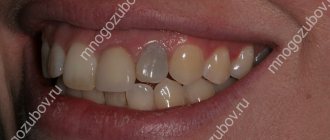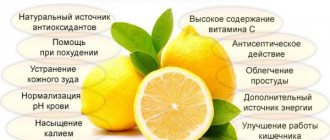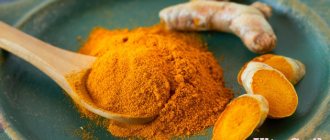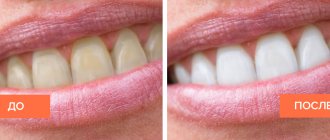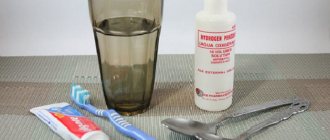Dental clinics offer teeth whitening services.
Of course, lightening the enamel using professional techniques will give quick results, but achieving it is not affordable for many.
Therefore, people try to find less expensive options.
Among all the available methods, preference is given to lemon.
Its proper use will make your smile snow-white and eliminate bad odor in your mouth.
Beneficial features
The unique properties of lemon, which give a person youth, beauty and health, have been proven through scientific research. This fruit contains substances and microelements beneficial to the body.
Among the important ones: vitamin C, vitamins P and D, as well as elements of group B. They help accelerate regenerative processes, prevent the proliferation of bacteria, and improve the condition of not only teeth, but even nails and hair.
Lemon juice has a teeth-whitening effect due to its strong acid concentration. When it interacts with the enamel, the coloring pigments are split, due to which the whitening effect is visible.
For the procedure of lightening the tone of teeth, both lemon juice and its zest are useful. The peel contains a large amount of calcium. Thanks to its combination with vitamin C, it is easily absorbed by the body and makes teeth and bones strong.
Since the concentration of vitamin C in the zest is higher than in the juice, its use can help get rid of gum problems. In particular, the use of the peel for medicinal purposes effectively stops bleeding gums.
In addition to the described qualities, lemon is able to cleanse the oral cavity of food debris and have a beneficial effect on strengthening the immune system.
Contraindications
Whitening at home using lemon has several limitations. This method is contraindicated for use:
- In childhood.
- Pregnant and breastfeeding women.
- People with an allergic reaction to lemon.
- In the presence of various infectious diseases in the oral cavity, including caries.
- In the case of thinned enamel, since the whitening procedure can have a destructive effect on it.
- For increased tooth sensitivity. This is because the acidity of citrus fruits can cause soreness.
- People with fillings and fixed dentures on their front teeth. After bleaching, the filling material will look like a yellow spot against the background of the natural color of the enamel.
- Immediately after removing braces. During prolonged wearing of the structure, the enamel becomes less strong.
- If there are chips on the teeth, as well as gum injuries.
- If a person is taking potent drugs. By reacting with acid, they can have unplanned effects on the body.
How to whiten teeth using folk remedies/at home?
The answer is simple: no way. Don't try to whiten your teeth with your grandmother's advice, you will only harm your teeth.
You should absolutely not use soda, tooth powders, lemon, activated carbon, etc. to whiten your teeth. The only result of such “whitening” will be erosion of tooth enamel.
Remember! Any folk remedies are a waste of time. The worst thing is that some of them can cause great harm to your teeth.
Here are a few ways for those who don't want to spend a lot of money on teeth whitening, but want to have white teeth:
- Visit the solarium a couple of times. Against the background of a dark-skinned body, teeth will appear whiter than usual.
- Get your teeth professionally cleaned every six months. Your teeth will have a healthy, natural color.
- Try not to overuse foods that can darken your teeth: coffee, tea, chocolate, blueberries, Coca-Cola, fruit, wine.
- Do not smoke.
Proven methods
There are many ways to use lemon as a natural enamel brightener. However, their effect on the pigment particles is the same, so you can choose any recipe you like.
Soda and lemon
One of the old but effective ways. Take a little baking soda and moisten it with lemon juice. Apply the mixture to the brush. Brush your teeth with this solution for about 5-10 seconds.
The total duration of the procedure should not exceed 20 seconds. After this, rinse your mouth with warm water. If you are afraid of damaging the enamel, you can use gauze instead of a brush.
Some consider this method dangerous, while others call it an excellent way to lighten teeth by 1-2 shades.
Please take some precautions when using this recipe:
- apply once every 2-3 months;
- do not overexpose the mixture on your teeth;
- Do not rub your teeth with force, even with gauze.
If you follow all the rules, whitening will not have a destructive effect on your teeth.
The appearance of bitterness in the mouth - what could it be and how to eliminate the problem? Read here what complications can occur after implantation of upper teeth.
At this address https://dr-zubov.ru/krasota-i-uxod/otbelivanie/professionalnoe/poryadok-provedeniya-texnologii-zoom-i-otzyvy-pacientov.html you will find reviews about Zoom 3 teeth whitening.
Essential oil
Consists of polymer compounds and active substance. This product has regenerating properties and also stimulates metabolic processes.
In addition to whitening enamel, it can heal wounds in the mouth and reduce tooth sensitivity.
To carry out the procedure, you will need to take a cotton swab and moisten it with lemon oil. Rub your teeth with it for about 5-7 seconds, wait another 20 seconds and rinse your mouth with warm water.
To achieve visible results, repeat the steps for one month once a week. Take a break next month. Then the course can be repeated. In one course, the enamel brightens by about 1-2 tones.
If you want to achieve greater results, mix this oil with tea tree oil.
In tandem with herbal decoction
It is necessary to brew pharmaceutical chamomile or calendula in a glass. After the broth has infused, pour out one third of it and save it for rinsing.
At this time, cut half a lemon and squeeze its juice into the remaining infusion. For the best and safest effect, it is necessary to maintain a proportion of 2 parts of the infusion to one part of citric acid.
Take a mixture of lemon juice and herbal decoction into your mouth and hold for about 10-15 seconds, and then rinse your mouth with the second part of the pure decoction.
Repeat the procedure once a week for one month. Those who have already tried this recipe talk about lightening the enamel by 2-3 tones per course.
Application of zest
Peel the fruit so that you are left with large or medium-sized crusts. Take a peel and rub the inside of each tooth.
To allow air to penetrate freely to your teeth, leave your mouth open for 3-5 minutes. After this, be sure to rinse your mouth with water. Whitening of 1-2 tones was noticed.
It is often impossible to carry out such actions. It is enough to use this recipe once every two months.
Fruit slices
Peel the fruit, cut its pulp into thin slices and apply them to the outside of your teeth. Wait about 2-3 minutes and rinse your mouth with water.
This method can be used no more than once a week for one month.
A longer period of clarification with pulp may destroy the structure of the surface layer. Within a month, the enamel will become 2-3 shades whiter.
Connection of three components
It is necessary to crush 2 tablets of activated carbon in a bowl. Add a little toothpaste and a few drops of lemon juice to the powder.
Then apply the mixture to the brush and brush your teeth for 2-3 minutes. It is recommended to use this product in a course of one to two months.
Despite the fact that this recipe uses a small amount of acid, for your own safety you should carry out the procedure no more than twice a week.
After a course of whitening, the enamel will noticeably lighten by 1-2 tones.
Features of Clarity braces, their advantages and disadvantages. On this page we offer a detailed description of foods that are harmful to teeth.
Follow the link https://dr-zubov.ru/lechenie/zuby/karies-z/cementa-skrytaya-patologiya-chrevataya-oslozhneniyami.html if you are interested in the clinical picture of dental cement.
With toothpaste
A good whitening effect can be achieved not only with the use of fresh juice, but also with crystallized citric acid.
Take toothpaste and apply it to your brush. Sprinkle table salt on top and add about 10 lemon crystals. Brush your teeth with this mixture and rinse your mouth with running water.
This method is not recommended to be used frequently. It is enough to conduct such events once every three months.
People with fragile enamel should not use this recipe.
Popular lineup
You will need to take half a teaspoon of baking soda and squeeze out the same amount of juice. Add 2-3 drops of 3% hydrogen peroxide to the mixture.
Apply the composition to the teeth and leave for 1-2 minutes. After the designated time has passed, you need to rinse your mouth with warm water. You will have to go without food and water for the next hour.
The product can be used up to 2 times a week for a month. The enamel may become 2-3 shades lighter.
The video explains in more detail the preparation and use of homemade pasta.
Pulp
This remedy is suitable for people with very yellow or dark teeth. However, before use, you should consult your dentist, since the use of the recipe is only possible for people with strong and thick enamel.
To prepare, you will need to peel the fruit, remove the dense inner films and seeds from it. Grind the pulp into a paste and apply it to your teeth. Leave your mouth slightly open and wait about five minutes.
Then you need to wash off the pulp and juice with warm running water.
Never use a brush to clean your mouth. This can damage the enamel after the procedure. The method is intended for one-time use.
Chewing the peel
This method is very simple but effective. Chewing a lemon peel for three to five minutes will lighten the enamel in areas that are difficult to reach with a brush. After spitting out the zest, rinse your mouth with water.
You can chew the zest 2-3 times every two weeks. Dentists do not recommend using it for people with sensitive teeth.
Reviews
Below are some reviews. If you have something to say, leave your feedback in the comments below the article, it will be useful to our readers.
Marina Nekrasova, Kislovodsk.
I tried buying different whitening pastes, but nothing helped, although I don’t smoke or drink coffee. My friend and I decided to try bleaching with lemon pulp, but, as it turned out, my enamel is too sensitive. But it helped my friend, and her results soon became noticeable. Still, you need to focus on tooth sensitivity.
Svetlana Krasina, St. Petersburg.
All my life I was embarrassed to smile widely; it always seemed to me that my teeth were not snow-white enough. My friends advised me to add 3 drops of lemon juice to the toothpaste every time I brush my teeth. I noticed the result within a couple of weeks, my front teeth became quite lighter.
Ekaterina Streltsova, Nizhny Novgorod.
I decided to try rubbing my teeth with lemon zest. The sensations are certainly not the most pleasant, but I think for the sake of beauty you can be patient a little. I've been doing this once every two weeks for a couple of months now. The result is not colossal, but quite noticeable.
Advantages
The benefits of lemon as a whitening agent are as follows:
- Availability and low cost not only compared to dental procedures, but also compared to many home remedies.
- High impact. When used correctly, the fruit can make your teeth several shades lighter.
- Disinfecting effect on the oral mucosa, which eliminates the spread of bacteria and infections.
- Using lemon zest or juice strengthens the body's immune system.
- The use of an acidic product freshens breath no worse than artificial mouthwashes.
- In some cases, lemon can relieve toothache.
- A universal remedy for most people.
Flaws
Recipes for teeth whitening using lemon have almost no disadvantages. However, any of the above should be used with caution. After all, if used incorrectly or frequently, there is a risk of destruction of the enamel structure.
After bleaching, the following problems may occur:
- Increased sensitivity of teeth when changing hot and cold foods. Usually this phenomenon goes away 3 days after the procedure.
- Irritation, inflammation, swelling in the soft tissues of the oral cavity due to exposure to citric acid in the mouth.
- The opposite effect is obtained - darkening of the surface of the teeth. This is due to the fact that the enamel structure is weakened after lightening and can absorb coloring pigments even more.
All the disadvantages indicate that if you decide to whiten your teeth at home, be sure to consult with your dentist.
He will examine the enamel for strength and tell you whether in your case it is worthwhile to lighten it at all.
Precautionary measures
Whitening with lemon is a fairly effective method. But it does not inspire confidence among dental specialists.
Often, having spared money for the services of professionals, people turn to doctors to eliminate the aggressive effects of lemon acid. This happens due to its careless use.
Before the procedure, it is necessary to carry out preparatory measures - carefully read the chemical composition of other ingredients in recipes, and also read about their reactions when interacting with lemon juice.
Before whitening, you must thoroughly clean your teeth of plaque, and after it, you should not eat foods with natural or artificial dyes for about three days. This will prevent your teeth from becoming even darker.
At the end of the procedure, be sure to rinse your mouth with water to neutralize any remaining acid in your mouth.
You should not frequently lighten the enamel. Such recipes should be used as rarely as possible. After all, exposure to acid makes teeth susceptible to bacterial penetration.
Why do teeth turn yellow and how to whiten them?
Dentists identify many different reasons that can cause darkening of tooth enamel - both natural and external. For example, why are fangs yellower than other teeth? Their structure is more dense, but the enamel itself does not have a specific color, so the shade of the teeth is determined by a deep layer called dentin. Due to the fact that the thickness of this layer is greatest in fangs, the color is more pronounced, and therefore the teeth appear more yellow than those next to them. Other common factors include the following:
- frequent consumption of products containing artificial colors;
- eating natural foods that can change the color of enamel;
- smoking;
- use of tetracycline over a long period of time;
- excess fluoride in the body (high fluoride content in daily consumed water can lead to the development of a disease called fluorosis);
- disorders associated with the functioning of the gallbladder and liver;
- natural aging processes.
